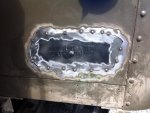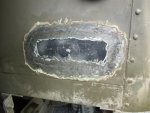michigan4x4
Member
- 131
- 1
- 18
- Location
- Romeo, Michigan
I widened the wheel wells of my M101a2 trailer and welded everything back together to give me over 48" between the wheel wells. To be honest, my welding is not the best and I had problems with burn through a few times.. Part of the reason was my Mig wasn't set properly and the other reason was that I was working outside and I think the shielding gas was blowing around a bit. Wasn't fun and had to spend a lot of time grinding big messy welds.
To make a long story short, I did so much grinding that I seemed to have thinned the metal on the wheel wells along the welded seam. Now, in order to restore some rigidity, from the underside, my plan is to fab up some 5 inch wide sheet metal patch panels and use 3m Panel bonding adhesive 8116 to set them in place along the underside of the welded seam. Anyone have any experience using this stuff. I know I should just pull the welder back out and weld them in but I seem to do more bad than good with the welder.
Suggestions, opinions etc..
Thanks
Jeff
To make a long story short, I did so much grinding that I seemed to have thinned the metal on the wheel wells along the welded seam. Now, in order to restore some rigidity, from the underside, my plan is to fab up some 5 inch wide sheet metal patch panels and use 3m Panel bonding adhesive 8116 to set them in place along the underside of the welded seam. Anyone have any experience using this stuff. I know I should just pull the welder back out and weld them in but I seem to do more bad than good with the welder.
Suggestions, opinions etc..
Thanks
Jeff
Last edited:





